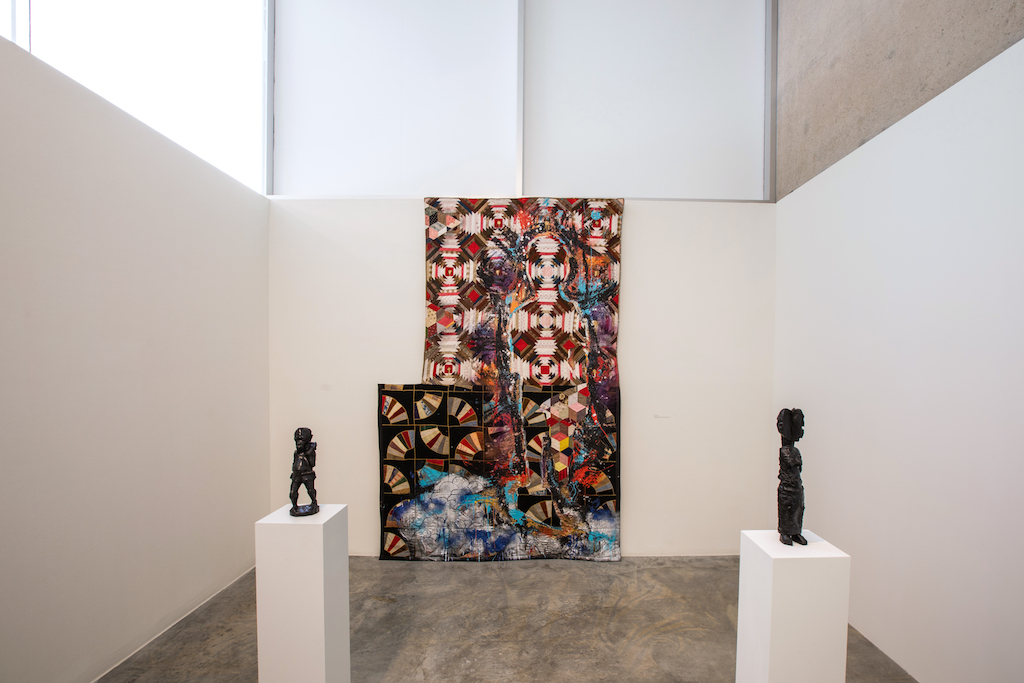[ad_1]

Installation view of “Sanford Biggers,” 2018, at Contemporary Art Museum, St. Louis.
DUSTY KESSLER
Currently on view at the Contemporary Art Museum in St. Louis is a survey of recent works by Sanford Biggers, whose sculptures, videos, and performances frequently merge unlike cultural histories and deal with trauma. Republished below is a profile of Biggers by Carly Berwick from the November 2000 issue of ARTnews. The article appeared in the magazine’s “On the Edge” section, which was devoted to emerging artists, and featured a look at Biggers’s early work. As Tom Finkelpearl, then the director of P.S. 1’s studio program, told Berwick, “Biggers is always juggling cultural signs.” —Alex Greenberger
“Power Spins”
By Carly Berwick
November 2000
Break-dancing B-boys and Buddhist mandalas find common ground in Sanford Biggers’s floors
Performers were stepping all over Sanford Biggers’s art at a Bronx break-dancing competition earlier this year. But their spinning and twisting only added to the creation of his piece. Mandala for the B-Bodhisattva #2 (2000)—an allusion to B-boys, a term deriving from break-dancers—consists not only of linoleum tiles painted in Escherlike diamonds and circles but also of performance taking place on the tiles and the scuff marks that remain.
In an exhibition at the Studio Museum in Harlem this fall, a two-inch monitor offered an overhead view of Biggers’s dancers skimming across the tiles. The mandala—a Buddhist symbol of the universe, typically taking the form of a circle enclosing a square—can be an object or movement. “Certain Tibetan monks dance in circles to create the mandala physically,” explains Biggers, who spent two years traveling through Japan and Asia after graduating from Atlanta’s Morehouse College in 1992.
The 29-year-old artist, whose father is a brain surgeon and mother a retired teacher, grew up in Los Angeles. The family’s house was filled with the African and Asian art that Biggers’s uncle, a merchant seaman, sent from abroad, as well as reproductions of contemporary African American paintings. After attending the Skowhegan School of Painting and Sculpture and receiving an MFA from the Art Institute of Chicago, Biggers won several grants, including P.S.1 and Studio Museum of Harlem residencies. Since 1991, he’s been in numerous group exhibitions and three solo shows, in Nagoya, Japan; Los Angeles; and Baltimore.
Tom Finkelpearl, director of P.S.1’s studio program, observes, “Biggers is always juggling cultural signs” and has “an incredible formal sense.” The Bodhisattva piece, he notes, combines “1970s process art, ’80s identity politics, and ’90s multimedia installations.”
Biggers appears unfazed by the glare of the spotlight. Just days before the Studio Museum opening, he was calmly putting the finishing touches on The Chronicle, a plaster sculpture of an Afro pick with projected images of ancient monuments and the cosmos flashing across the top. He aims to achieve the resonance of the so-called power objects of indigenous art—a category that includes African fetish figures. Discussing Hangman’s House (1999), a battered book with metal nails sticking out of it, he explains that tribes in the Congo use figures with nails, or nkisi, to scare away enemy spirits. “So I use them in a book to ward off the bad memory of America being a hangman’s house, the site of so many lynchings.”
While pieces like the B-Bodhisattva or Bounce, Rock, Skate, Rock, Roll (2000), made of a skateboard and roller-skate wheels that resemble African beadwork, offer an almost jubilant take on the collision of cultures, other works are more fraught. Bittersweet the Fruit (1999)—a tree with a video screen in its trunk, and headphones hanging from it like a noose—is a memorial to James Byrd, who in 1998 was tied to a pickup truck and dragged to his death in Texas. The history of lynchings reverberates through the dangling headphones, which pipe in music accompanying a video of Biggers playing piano naked in the woods. “The idea was to present the image of a nude black male,” says Biggers. “But in this case, he’s playing songs, songs of freedom.”
A version of this story originally appeared in the November 2000 issue of ARTnews on page 224 under the title “Power Spins.”
[ad_2]
Source link

